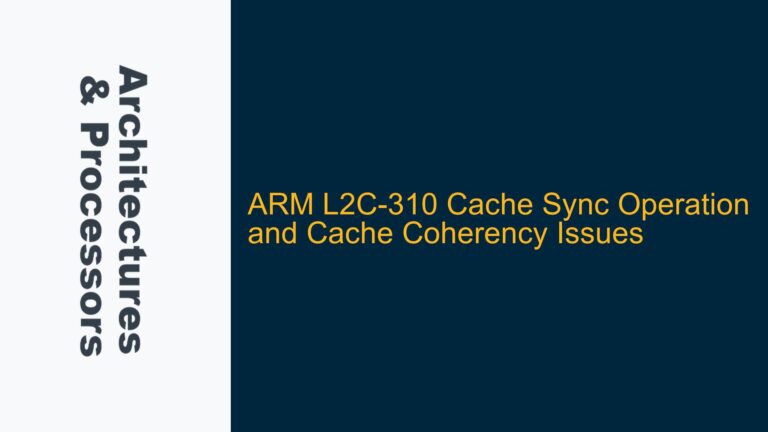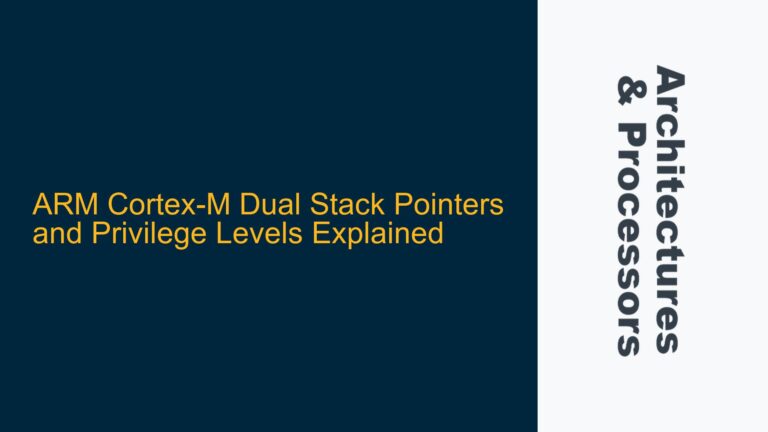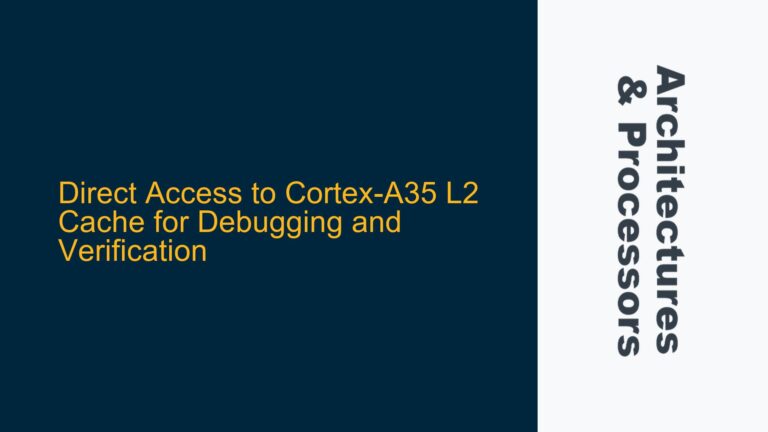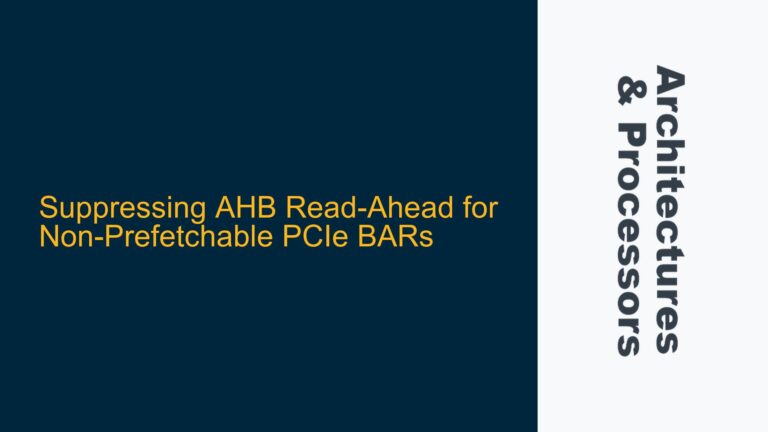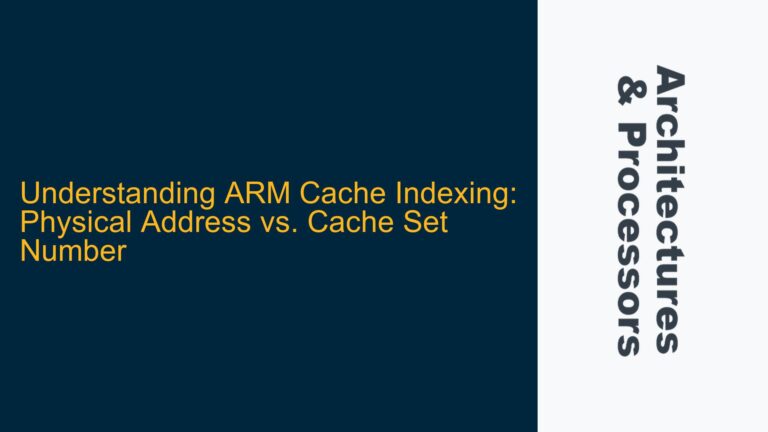ARM Cortex-A72 Memory Access Tracing Limitations
The ARM Cortex-A72 processor, a high-performance core within the ARMv8-A architecture, is widely used in applications requiring significant computational power, such as mobile devices, networking equipment, and embedded systems. However, one of the notable limitations of the Cortex-A72 is its lack of support for data access tracing through Embedded Trace Macrocell (ETM) technology. ETM is a powerful debugging feature that allows developers to trace instruction execution and, in some cases, data accesses. While the Cortex-A72 supports instruction tracing, it does not provide the capability to trace memory accesses, which can be critical for performance analysis, debugging, and optimization.
The absence of data access tracing in the Cortex-A72 is particularly significant because memory access patterns often reveal performance bottlenecks, cache inefficiencies, and other subtle issues that are not immediately apparent through instruction tracing alone. For example, understanding how a process accesses memory can help identify cache misses, unnecessary data transfers, or inefficient memory layouts. Without data access tracing, developers must rely on alternative methods to gather this information, which can be less efficient and more complex.
The Statistical Profiling Extension (SPE), introduced in ARMv8.2, offers some capabilities for sampling memory accesses, but it is not available on the Cortex-A72, which is based on ARMv8.0. This leaves developers with limited options for directly tracing memory accesses on this processor. The lack of native support for data access tracing in the Cortex-A72 necessitates the use of external tools or software-based solutions to achieve similar functionality.
Challenges in Memory Access Tracing on Cortex-A72
The primary challenge in tracing memory accesses on the Cortex-A72 stems from the architectural design of the processor and its associated debugging features. The Cortex-A72 is optimized for high performance and power efficiency, which often comes at the cost of detailed observability. The ETM in the Cortex-A72 is designed to provide instruction tracing, which is sufficient for many debugging scenarios but falls short when detailed memory access patterns are required.
One of the key reasons for the lack of data access tracing in the Cortex-A72 is the complexity and overhead associated with capturing every memory access in real-time. Memory accesses occur at a much higher frequency than instruction executions, and tracing every access would generate a massive amount of data, which could overwhelm the debugging infrastructure. Additionally, the Cortex-A72’s focus on performance means that adding hardware support for data access tracing could introduce latency or reduce the overall efficiency of the processor.
Another challenge is the integration of memory access tracing with other debugging and profiling tools. Even if data access tracing were available, it would need to be seamlessly integrated with existing tools to provide a comprehensive view of the system’s behavior. This integration is non-trivial, as it requires coordination between the hardware, firmware, and software layers. The absence of such integration in the Cortex-A72 further complicates the task of tracing memory accesses.
Alternative Solutions for Memory Access Tracing on Cortex-A72
Given the limitations of the Cortex-A72 in terms of native data access tracing, developers must rely on alternative solutions to achieve similar functionality. One such solution is the use of dynamic binary instrumentation tools like DynamoRIO. DynamoRIO is a powerful framework that allows developers to analyze and modify the behavior of applications at runtime. It provides a tool called memtrace, which can be used to trace memory accesses by intercepting and recording every memory operation performed by the application.
DynamoRIO works by inserting instrumentation code into the application’s binary at runtime. This instrumentation code captures memory accesses and logs them for later analysis. While this approach introduces some overhead, it provides a level of detail that is not achievable with the Cortex-A72’s native debugging features. The memtrace tool can be particularly useful for identifying memory access patterns, detecting cache inefficiencies, and optimizing memory usage.
Another alternative is the use of performance monitoring units (PMUs) available in the Cortex-A72. PMUs provide counters that can be used to monitor various aspects of the processor’s behavior, including cache hits, cache misses, and memory bandwidth usage. While PMUs do not provide direct memory access tracing, they can offer valuable insights into memory-related performance issues. By correlating PMU data with instruction traces, developers can infer memory access patterns and identify potential bottlenecks.
In addition to DynamoRIO and PMUs, developers can also consider using simulation-based approaches for memory access tracing. Tools like ARM Fast Models or QEMU can simulate the behavior of the Cortex-A72 and provide detailed traces of memory accesses. These simulations can be particularly useful during the early stages of development, where hardware may not be available or where detailed observability is required. However, simulation-based approaches are typically slower than running on actual hardware and may not capture all the nuances of real-world behavior.
For developers who require real-time memory access tracing on the Cortex-A72, a combination of these alternative solutions may be necessary. By leveraging dynamic binary instrumentation, performance monitoring units, and simulation tools, developers can gain a comprehensive understanding of memory access patterns and optimize their applications accordingly. While these solutions may not be as straightforward as native data access tracing, they provide a viable path forward for overcoming the limitations of the Cortex-A72.
Implementing Memory Access Tracing with DynamoRIO
To implement memory access tracing using DynamoRIO on the Cortex-A72, developers must first set up the DynamoRIO environment. This involves downloading and installing the DynamoRIO framework, which is available for various platforms, including Linux and Windows. Once installed, developers can use the memtrace tool to trace memory accesses in their applications.
The first step in using memtrace is to identify the target application and the specific memory accesses that need to be traced. This can be done by running the application under DynamoRIO with the memtrace tool enabled. The memtrace tool will intercept every memory access made by the application and log it to a file. The logged data includes the memory address, the type of access (read or write), and the size of the access.
Once the memory accesses have been logged, developers can analyze the data to identify patterns and potential issues. For example, they can look for repeated accesses to the same memory location, which may indicate a cache inefficiency. They can also identify memory accesses that occur in a specific sequence, which may reveal a performance bottleneck. The memtrace tool provides a detailed view of memory access patterns, which can be used to optimize the application’s memory usage and improve overall performance.
While DynamoRIO provides a powerful solution for memory access tracing, it is important to note that it introduces some overhead. The instrumentation code inserted by DynamoRIO can slow down the application, particularly if it is performing a large number of memory accesses. Developers should be aware of this overhead and take it into account when using DynamoRIO for memory access tracing. In some cases, it may be necessary to limit the scope of the tracing to specific parts of the application to reduce the impact on performance.
Leveraging Performance Monitoring Units for Memory Analysis
Performance Monitoring Units (PMUs) in the Cortex-A72 offer another avenue for analyzing memory access patterns. PMUs provide a set of counters that can be configured to monitor various aspects of the processor’s behavior, including cache hits, cache misses, and memory bandwidth usage. While PMUs do not provide direct memory access tracing, they can offer valuable insights into memory-related performance issues.
To use PMUs for memory analysis, developers must first identify the specific events they want to monitor. For example, they may want to monitor the number of L1 cache misses or the amount of data transferred between the L2 cache and main memory. Once the events have been identified, developers can configure the PMU counters to track these events during the execution of the application.
The data collected by the PMU counters can be used to infer memory access patterns and identify potential bottlenecks. For example, a high number of L1 cache misses may indicate that the application is accessing memory in a non-optimal pattern, leading to increased latency. Similarly, a high amount of data transferred between the L2 cache and main memory may suggest that the application is not making efficient use of the cache hierarchy.
To get the most out of PMU-based memory analysis, developers should combine PMU data with instruction traces. By correlating PMU events with specific instructions, developers can gain a deeper understanding of how memory accesses are affecting performance. This combined approach can help identify the root cause of performance issues and guide optimization efforts.
Simulation-Based Memory Access Tracing with ARM Fast Models
For developers who require detailed memory access tracing during the early stages of development, simulation-based approaches can be a valuable tool. ARM Fast Models and QEMU are two popular simulation tools that can be used to simulate the behavior of the Cortex-A72 and provide detailed traces of memory accesses.
ARM Fast Models are high-performance simulation models that accurately replicate the behavior of ARM processors, including the Cortex-A72. These models can be used to run unmodified software and provide detailed traces of memory accesses, instruction execution, and other system events. The traces generated by ARM Fast Models can be analyzed to identify memory access patterns, detect cache inefficiencies, and optimize memory usage.
QEMU is another simulation tool that can be used for memory access tracing. QEMU is an open-source emulator that supports a wide range of architectures, including ARM. While QEMU may not provide the same level of detail as ARM Fast Models, it can still be used to generate memory access traces and analyze memory-related performance issues.
Simulation-based approaches are particularly useful during the early stages of development, where hardware may not be available or where detailed observability is required. However, it is important to note that simulation-based approaches are typically slower than running on actual hardware and may not capture all the nuances of real-world behavior. Developers should use simulation-based tracing as a complement to, rather than a replacement for, real-world testing and analysis.
Conclusion
The ARM Cortex-A72 processor, while highly capable in terms of performance, presents significant challenges when it comes to tracing memory accesses. The lack of native support for data access tracing through ETM technology means that developers must rely on alternative solutions to achieve similar functionality. Tools like DynamoRIO, performance monitoring units, and simulation-based approaches offer viable paths forward, each with its own strengths and limitations.
DynamoRIO’s memtrace tool provides detailed memory access tracing by intercepting and logging every memory operation performed by the application. While this approach introduces some overhead, it offers a level of detail that is not achievable with the Cortex-A72’s native debugging features. Performance monitoring units, on the other hand, provide valuable insights into memory-related performance issues by tracking events such as cache hits and misses. By combining PMU data with instruction traces, developers can infer memory access patterns and identify potential bottlenecks.
Simulation-based approaches, such as ARM Fast Models and QEMU, offer detailed memory access tracing during the early stages of development. These tools can be particularly useful for identifying memory access patterns and optimizing memory usage before hardware is available. However, simulation-based approaches are typically slower than running on actual hardware and may not capture all the nuances of real-world behavior.
In conclusion, while the Cortex-A72’s lack of native data access tracing presents challenges, developers have several alternative solutions at their disposal. By leveraging dynamic binary instrumentation, performance monitoring units, and simulation tools, developers can gain a comprehensive understanding of memory access patterns and optimize their applications accordingly. These solutions, while not as straightforward as native data access tracing, provide a viable path forward for overcoming the limitations of the Cortex-A72.

